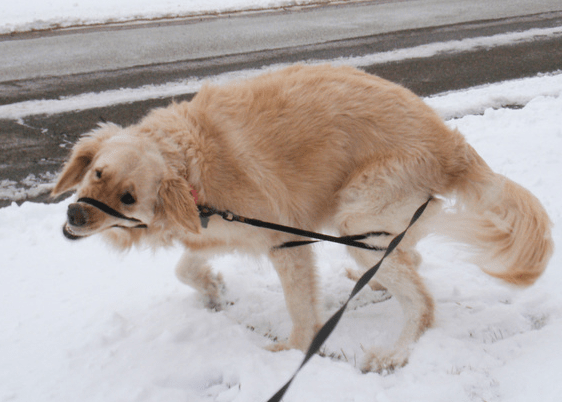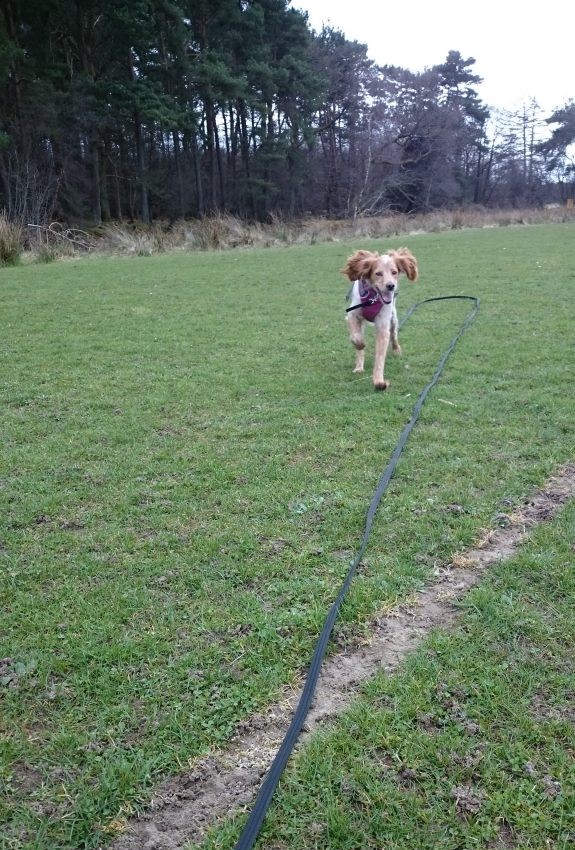THOUGHTS ON FLEXI LEADS...
 Flexi leads (or retractable leads) extend in length when your dog pulls and then retract into a plastic casing when the dog returns to you, or as you catch up with your dog. They have a manual braking system to stop your dog from going further than you want them to.
Flexi leads (or retractable leads) extend in length when your dog pulls and then retract into a plastic casing when the dog returns to you, or as you catch up with your dog. They have a manual braking system to stop your dog from going further than you want them to.
Many of my new puppy owner clients ask me what my thoughts are on flexi leads. My answer: I absolutely detest them! I wish they had never been invented!
They are dangerous for many reasons and are completely detrimental to the dog and owner relationship that we try to build during training.
Why are they dangerous for dogs?
From a dog safety aspect, if your dog is happily trotting along the road five metres in front of you and then sees something interesting on the other side of the road, all it takes is a split second for them to react and lunge out across the road to whatever they have seen. It may be a cat, it may be a bird, it may be another dog, or perhaps just a leaf or some litter blowing about. Dogs are much more aware of their environment than us humans are. And if there is oncoming traffic, your dog would be hit instantly. If you have a look on google, you will find that these types of accidents do happen – more than you think.
Another scenario is if your dog suddenly lunges at the end of the flexi lead, or lunges while the lead is locked out, they can pull it out of your hand quite easily. You then have a big noisy plastic casing bumping along the pavement behind your dog. This can be scary for many dogs and can set them off running trying to get away from it. Of course the faster your dog goes, the faster the scary noisy thing chases your dog. So they run faster! And before you know it, you have a terrified dog disappearing into the distance. This can have serious mental implications going forwards too.

When encountering another dog whilst on a walk, if your dog is sociable and goes over to say hello, the lead can very quickly become wrapped around either or both dogs and if it becomes tight it acts like garrotting wire. Injuries can happen in seconds.
Some retractable leads extend up to 33 feet. If your dog is that far away from you and you need to react to a situation, the distance is simply too great to allow you to do so. Your dog can round corners way before you can see what is around the bend. Many footpaths are also bridleways; what if there was a horse around the bend? You may suddenly realise that an approaching dog actually doesn’t want your dog to go over to say hello, but when they are that far in front you can’t rectify the situation quickly enough.
The Dangerous Dogs Act isn’t just relevant for dogs that bite. It also applies to dogs that are deemed to be dangerously out of control. A dog on an extended flexi lead running over to people and perhaps jumping up at children and knocking them over falls into that category. Flexi leads simply don’t allow an owner enough control over their dog whilst out in public.
Flexi leads can also cause serious damage to a dogs’ neck if they are attached to a collar. If the dog is running on the lead and suddenly comes to the end of the line, the dog’s neck will snap backwards with a strong jerking motion and can cause injuries similar to whiplash. Not only can this damage the delicate tissues around the dog’s neck, it can also cause spinal injuries.
Are they dangerous for humans too?
Yes, most definitely! Another quick internet search will illustrate the awful injuries that can occur as a result of using flexi leads. A dog suddenly lunging on a flexi lead generally causes the owner to react to the situation by grabbing the lead. Flexi leads either have a cord type line or a tape line. Both of these cause serious injuries if grabbed whilst the line is extending – it isn’t uncommon for people to lose fingers.
Excitable dogs can easily wrap the lead around peoples’ legs, causing rope burns and deep lacerations.
The nature of the tension in the flexi lead when the dog pulls can easily result in the owner ending up on the floor if the line gets wrapped around ankles or lower limbs.
But is it not good to give my dog more freedom?
New dog owners generally think that they are doing their dogs a favour by putting them on a flexi lead. They think it is nice that they are allowing their dogs more freedom on the end of the lead, but if you do this you are actually creating problems for yourself. Flexi leads teach dogs to pull! A dog very quickly learns that if they pull, they can go further and can get to whatever smell or object they are interested in. This teaches your dog to completely disengage from you because the environment becomes more rewarding.
Another point to note here is that regardless of how close your dog is to you, there is always tension on the flexi lead. When we train dogs to walk nicely on the lead, we teach them that a loose lead free from any tension is good. Therefore flexi leads are completely detrimental to this type of training.
So what should I use then?
A soft standard length lead is a good option and preferable to a flexi lead. Our favourite lead to use at Confident Canines HQ is a Halti training lead. It has clips at both ends of the lead meaning that you can adjust the length of the lead from 1m to 1.4m and 1.7m. This means that you can give your dog extra freedom to sniff if the situation allows, but you still have control over them.
The best approach when training a dog is to train them to walk nicely on the lead and also to train recall at the same time. This means that you can have a dog that doesn’t pull on a standard length lead and that can also be let off the lead in public to have their freedom to sniff and run about when the situation allows it.
What if I am teaching my dog recall?
Flexi leads are an absolute no-no for recall training too. As mentioned previously, having the bulky plastic casing dragging along behind your dog is scary and can cause them to bolt. The important factor for recall training is for your dog to feel that they have freedom whilst off the lead. Having them pulling on a flexi lead with tension on it has completely the opposite effect.
The best training aid to use for recall practice is a recall line. This is basically a long lead made from a soft webbing or waterproof material that replaces a short lead during recall practice. We love the rubberised lines from Handmade Hound (available on our web shop) or the PVC coated lines. As a minimum, the Coachi 10m line offers light padding. Avoid the cheap nylon lines as they will easily shred your hands, especially if you have a strong dog!

A recall line gives your dog freedom to sniff and run about, and gives you the perfect opportunity to be able to practice recall whilst still having hold of the end of the long line for safety.
It is important to note that when using a recall line you should attach it to a harness and not a collar. If your dog dashes off to investigate something whilst on a long line, you can cause serious damage to their neck if it is attached to a collar.
Having the line attached to a harness means that their body takes the impact of any sudden tension and it is much safer for them.
Can you help me?
Yes! We regularly help people to teach their dogs how to walk nicely on the lead and how to recall to them in public spaces.
GET IN TOUCH if you would like some one-to-one training to help resolve your issues. Alternatively, we also run group training classes which focus on teaching your dog to walk nicely on the lead and be under better control whilst out in public.
We are based in Leyland but cover most areas within a 10 mile radius.
Typical areas include: Leyland, Penwortham, Lostock Hall, Bamber Bridge, Eccleston, Chorley, Euxton, Croston, Longton, New Longton, Clayton-Le-Woods, Whittle-Le-Woods, Walton-Le-Dale, Hutton, Much Hoole, Brindle, Wheelton, Heapey, Hoghton.
If you are outside of the 10 mile radius, please contact us. We will travel further but may have to add a small surcharge to cover fuel costs.




